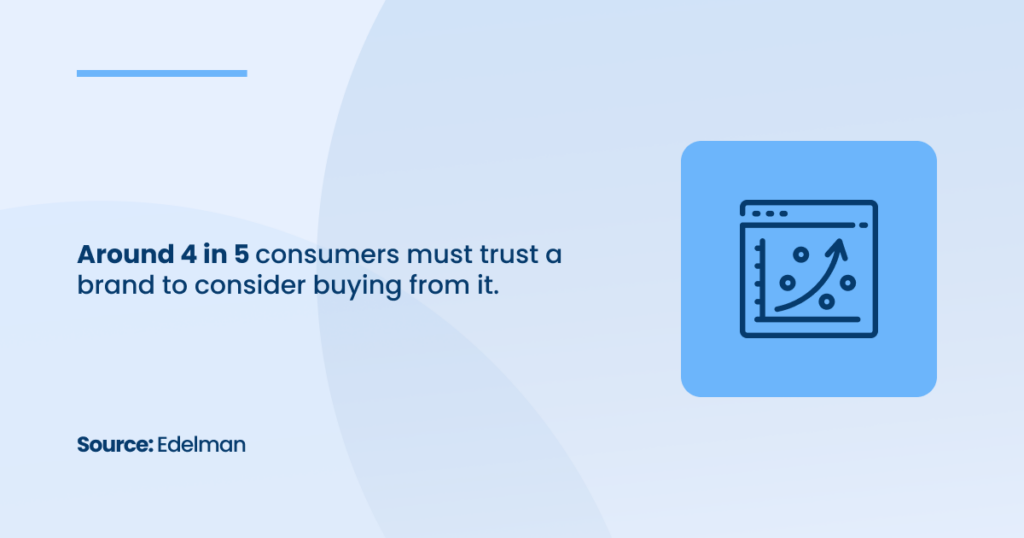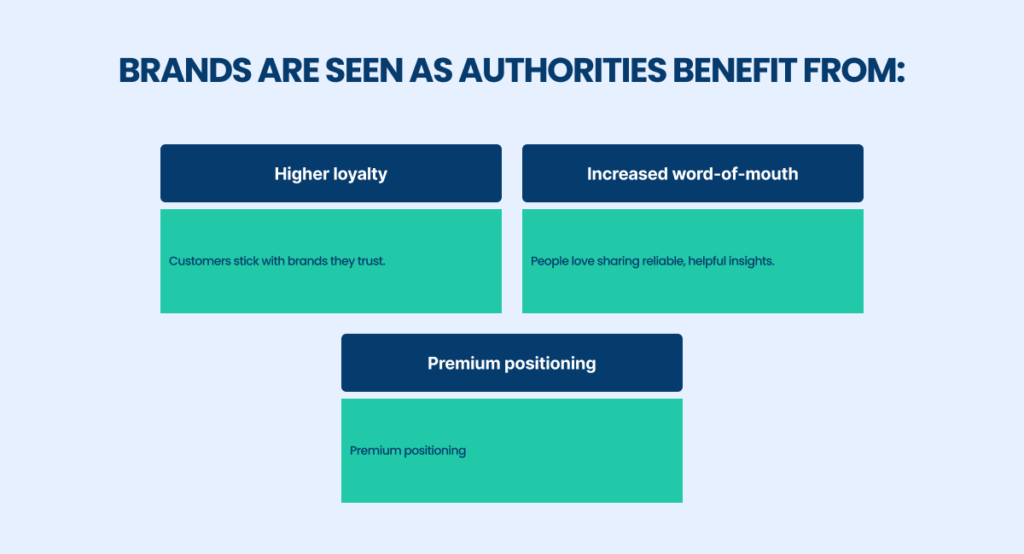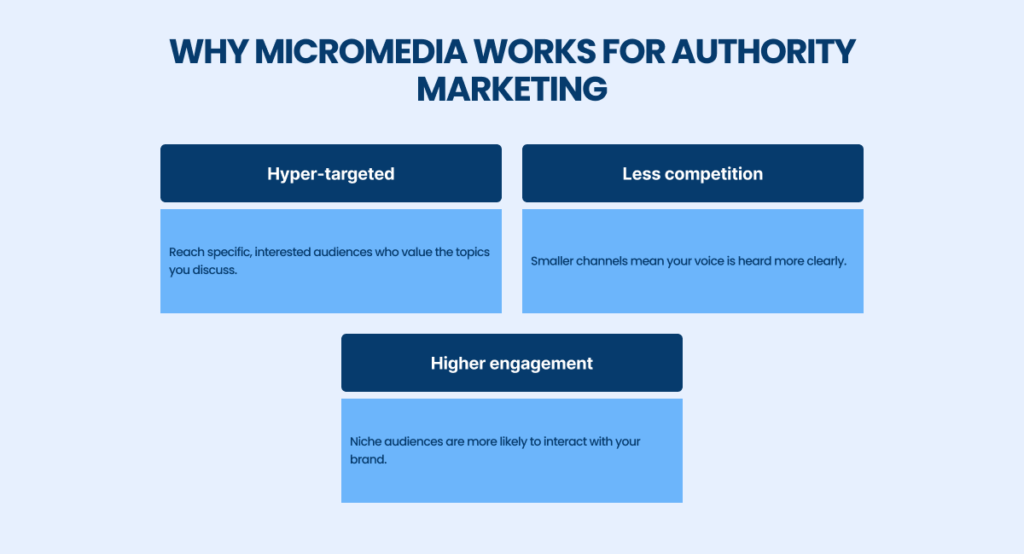- 81% of consumers need to trust a brand to consider buying
- 77% of consumers prefer shopping with brands they follow on social media
- 65% of consumers say a brand’s CEO and employees influence their decision to buy
The statistics highlight that trust has become more than a necessity in the digital-first world—it’s the ultimate currency and the lifeblood of any successful brand.
Businesses can boast about products, pricing, or even flashy marketing, but without credibility, none truly matters.

Trust makes customers loyal, transforms them into advocates, and propels brands to new heights.
This is where a professional Thought Leadership Agency can help to strategically position your brand as a trusted authority in the industry.
In this guide, we’ll dive into why trust is every business’s most valuable currency today and how it shapes brand perception and strategies.
What’s Driving the Trust Revolution?
Trust has become one of the most important metrics for a brand’s success.
As we navigate through a time of economic instability, fast-paced digital transformation, and heightened consumer awareness, trust is the anchor that keeps customers loyal and companies resilient. But why has trust become such a pivotal focus? What has led to this trust revolution?
In an age where consumers have endless choices at their fingertips, loyalty is no longer guaranteed by the quality of a product alone.
Source: Leading ways to show loyalty to a brand or company, Statista
Today’s customers are savvy, seeking authenticity and transparency from brands, and they expect companies to operate with integrity. Brands that fail to meet these expectations quickly lose relevance, regardless of how great their product may be.
The key factors driving the trust revolution:
- Economic Instability and Market Volatility
The last few years have shown how unpredictable the market can be. Recessions, global crises, and economic shifts have shaken consumer confidence, pushing people to seek stability wherever they can find it.
Brands that project trust and reliability become anchors in uncertain times, attracting consumers looking for safe and consistent choices. CEOs who focus on building brand reputation and fostering trust create brands that customers can depend on, no matter the economic climate.
- Digital Transformation: A Double-Edged Sword
The digital transformation has brought incredible opportunities and new challenges for businesses.
On one hand, technology allows brands to connect with customers in personalized, real-time ways, building a sense of closeness and accessibility. However, this same technology has heightened transparency, and consumers are more aware than ever before of brand behavior. One negative review or social media scandal can damage trust overnight.
Brands that navigate digital transformation with integrity and purpose can use it as a powerful tool for trust-building.
- Rise of the Conscious Consumer
Today’s consumers are more informed and mindful of the impact of their purchases. They care about sustainability, ethics, and corporate responsibility, choosing brands that align with their values.
For example, recent studies show that 70% of consumers prefer to buy from brands they trust with their data.
Business leaders prioritizing thought leadership and authority marketing are better positioned to capture this audience as they demonstrate a commitment to authenticity and transparency.
- Information Overload and the Desire for Clarity
We live in an era of content saturation. With so many options, consumers are overwhelmed and often skeptical of advertising messages. In response, they look for brands that offer clear, honest information rather than hype.
Thought leadership marketing plays a crucial role here, as it helps establish a brand as a credible voice amidst the noise. Brands that educate, inform, and engage in meaningful ways gain an edge in a crowded market.
CEOs who invest in authority marketing and foster a reputation for expertise help their brands cut through the noise and build lasting relationships with customers.
In a world where economic and technological changes continue to reshape how we do business, trust has emerged as the most valuable currency. Brands that understand and act on this trust revolution can secure a solid foundation for growth and resilience.
From Intangibles to Impact: Measuring Trust in Business Terms
For today’s CEOs, understanding the financial and strategic value of brand trust is more crucial than ever. However, trust is a nuanced concept.
Unlike sales or profit margins, trust may seem intangible.
But there’s good news: trust is measurable—and it has real, quantifiable impacts on revenue, loyalty, and growth.
Source: Edelman
To successfully incorporate trust into your business strategy, you must consider it a multi-dimensional concept. Here’s how to break down and measure trust in ways that align with your business objectives:
- Credibility
Credibility is the foundation of brand reputation. It’s built through expertise, reliability, and consistent messaging. When your customers see that you’re knowledgeable and reliable, they’re more likely to trust your brand.
Regarding thought leadership marketing, credibility can be enhanced by regularly sharing valuable insights and educating your audience—think blog posts, whitepapers, and webinars that demonstrate your expertise.
How to Measure Credibility:
- Track mentions and engagement on your thought leadership content (blogs, articles, videos).
- Review customer feedback for indications of perceived authority and expertise.
- Evaluate social media metrics to see how your industry peers and audience interact with your thought leadership content.
- Reliability
Reliability is your ability to deliver on promises. Customers know they can count on you if your product or service consistently meets or exceeds expectations. This is especially vital in digital transformation leadership, where rapid technological changes can challenge consistency.
Source: Most valuable brands worldwide in 2024, Statista
How to Measure Reliability:
- Use customer satisfaction scores (CSAT) or Net Promoter Scores (NPS) to gauge reliability.
- Analyze repeat customer rates as an indicator of trust in product consistency.
- Monitor response times and service accuracy in customer support.
- Transparency
Transparency is crucial to brand credibility in the age of information. Consumers today have high standards for honesty, especially regarding data privacy, company policies, and pricing. If your brand is transparent, customers will feel that they have the full picture, which builds confidence and loyalty.
How to Measure Transparency:
- Track your customer complaints and resolution rates—lower rates may indicate fewer hidden issues.
- Monitor open rates and engagement on communications about policies or updates, as transparency can improve these metrics.
- Look at customer loyalty over time to see if transparency initiatives help retain your audience.
- Alignment with Customer Values
Today’s consumers expect companies to reflect their values. Customers are more likely to trust brands that support causes they care about and align with their personal beliefs. Brand credibility is increasingly tied to social responsibility, sustainability, and ethical practices.
How to Measure Value Alignment:
- Conduct regular customer surveys on brand perception and value alignment.
- Monitor online reviews and feedback for mentions of ethics or social responsibility.
- Assess engagement with your corporate social responsibility (CSR) initiatives on social media and other platforms.
Incorporating these dimensions into your business strategy isn’t just beneficial; it’s essential.
Brands that invest in building credibility, reliability, transparency, and values alignment enjoy stronger loyalty and more resilient growth. You can measure trust as an actionable and impactful business asset by monitoring these dimensions with clear metrics.
Authority Branding: Become the Go-To Expert in Your Industry
Becoming the trusted expert gives your brand an undeniable edge.
Authority branding establishes your brand as the go-to source for knowledge, insights, and reliability in your field. This strategy isn’t about pushing products—it’s about creating a foundation of brand credibility by offering genuine value to your audience.
Why Authority Matters in Branding
When customers trust that your brand knows its field inside out, they’re more likely to turn to you for solutions.

Customers need stability in a world where digital transformation leadership and constant change are the norms.
They need trusted voices to guide them, especially when facing new trends or challenges.
Thought Leadership: Your Gateway to Authority
Thought leadership is more than a buzzword. It’s a way for brands to showcase expertise and stand out as knowledgeable, forward-thinking, and value-driven.
- Share Industry Insights
Regularly publishing industry insights positions your brand as a thought leader. Whether it’s a blog post, LinkedIn article, or a video update, each piece you share should aim to educate, inspire, or solve a problem.
Instead of focusing on direct sales, discuss trends, challenges, and best practices in your industry.
- Provide Actionable Advice
Today’s audiences crave practical knowledge. Offer advice that your audience can apply immediately, even if it doesn’t directly link to your product.
For instance, a thought leadership marketing strategy that focuses on “how-to” guides or insights into trends will showcase your brand’s understanding without being salesy.
- Lead Transparent Conversations
Transparency is crucial. Openly discussing challenges your industry faces, even when they affect your brand, builds trust. Address how your brand is navigating changes, such as new regulations or digital transformations.
Customers appreciate brands that are honest about their journey.
- Create a Bridge of Trust Through Non-Sales Content
CEOs should focus on creating a relationship with their audience.
This means not every piece of content should be a sales pitch. Share stories from your brand’s journey, highlight employee achievements, or showcase customer success stories. Humanizing your brand builds trust and makes it more relatable.
Thought Leadership Examples That Build Authority
To inspire, here are a few thought leadership examples that build trust and authority:
- CEO Insights Series: A regular column that shares perspectives on industry trends.
- Educational Webinars: Monthly sessions on common pain points in your industry.
- Case Study Breakdowns: Explain real-life examples of how your approach solved specific challenges.
These tactics don’t just inform—they position your brand as a pillar of authority that customers and peers look up to.
Leveraging Micromedia: Reach Your Audience in Authentic Spaces
Micromedia—small-scale, niche platforms like blogs, podcasts, and community sites—are the new playgrounds for authentic brand engagement. These channels allow brands to connect deeply with specific audiences, often with much more engagement than larger, more saturated media.
Why Micromedia Works for Authority Marketing
Traditional advertising can be broad, which means you may end up reaching a lot of people outside your target audience.
But with micromedia, you’re speaking directly to the people most interested in your message.

How to Leverage Micromedia for Maximum Impact
Here’s how to get the most out of micromedia:
- Identify Relevant Platforms
Find where your audience is most engaged. Are they listening to industry podcasts, following certain blogs, or active in LinkedIn groups? These are the spaces where your voice can resonate powerfully. Remember, people trust recommendations from sources they already follow.
- Create Authentic Content
When using micromedia, prioritize authenticity. This isn’t the place for scripted ads or polished sales pitches. Instead, share insights, tell stories, or offer solutions in a conversational, relatable tone. Engaging on podcasts with real stories from your business or sharing personal challenges faced by your team can make a big impact.
- Invite Influencers in Your Industry to Collaborate
Partner with micromedia influencers who share your audience. This can take the form of co-authored blogs, joint webinars, or guest appearances. Not only does this give your brand a trust transfer through association, but it also expands your reach to new audiences.
- Offer Consistent Value
Frequency matters in micromedia. Consistency builds recognition, whether it’s a monthly guest spot on a podcast or a regular blog contribution. It positions your brand as a familiar presence in your field and strengthens authority.
The Power of Association: Trust Through Strategic Partnerships
When it comes to trust-building, association matters. By partnering with reputable brands, you create an instant trust transfer.
Source: Influencer Marketing Hub
When customers see you working alongside a respected brand, that brand’s credibility extends to you, instantly enhancing your reputation.
Why Partnerships Boost Brand Credibility
When brands collaborate, it signals to customers that each sees value in the other. Strategic partnerships can:
- Increase visibility: Gain exposure to the partner’s audience.
- Enhance credibility: Borrow trust from reputable brands.
- Broaden expertise: Position your brand as part of a larger, knowledgeable network.
Data Transparency: Be Open About How You Use Consumer Data
In today’s digital landscape, data transparency isn’t just good practice; it’s essential to brand credibility.
For consumers, data privacy is no longer a minor concern but a primary factor influencing which brands they choose to engage with. Being open about how consumer data is collected, stored, and used creates a sense of security for your customers.
Source: Allied market research
For CEOs and business leaders, data transparency isn’t just a legal checkbox—it’s a tool to build trust and loyalty.
Consider this: Over 70% of consumers reported that they are more loyal to companies that are transparent about how their data is used.
This isn’t surprising—data represents a deeply personal aspect of each customer.
In an age where so much about consumer behavior and preferences is tracked, honest communication about data handling has become a way to foster trust and distinguish your brand.
Let’s face it: the average consumer may not fully understand the technical aspects of data collection or storage. However, they understand what it means for their privacy to be respected. Clear, straightforward language about data policies goes a long way.
Rather than relying on dense legal jargon, brands that communicate data practices in plain terms demonstrate that they prioritize customers’ comfort and understanding.
Thought leaders in this space have adopted the practice of sending simple, accessible notices about data use and even providing quick Q&A formats about consumer rights and data practices.
Leading by example, companies like Apple have made data privacy a core part of their brand identity, emphasizing their “privacy by design” approach in marketing campaigns and user notifications.
Google’s “My Activity” feature, allowing users to see what data is stored and adjust privacy settings, is another example. These brands don’t merely say they care about privacy—they show it by being transparent, proactive, and putting control in the hands of the consumer.
For CEOs, embracing such transparency can mean not only higher trust but a lasting brand image that values ethical practices over mere profits.
Additionally, the approach to data transparency should extend beyond simply publishing policies on your website.
Engage with your customers about data use, either through periodic updates, newsletters, or even personal branding strategies on LinkedIn.
A CEO’s commitment to privacy can be highlighted as part of thought leadership content, which underscores the brand’s values and reassures customers that they’re in safe hands.
Remember, transparency is not about presenting a polished image—it’s about openly sharing the brand’s principles and practices, which, in turn, leads to enhanced brand credibility.
Privacy & Security as Core Values
In a time of frequent data breaches and heightened consumer awareness, privacy and security aren’t just technical concerns—they are core components of brand trust.
CEOs and business leaders must recognize that robust cybersecurity practices and transparent privacy policies are more than compliance obligations; they are key differentiators that set trustworthy brands apart.
The demand for privacy and security goes beyond avoiding regulatory fines. Today, customers equate strong security practices with respect.
When a company demonstrates that it’s serious about protecting customer data, it’s showing that it values its relationship with its customers. Privacy and security practices, therefore, play a crucial role in fostering customer loyalty and enhancing brand reputation.
A strong example of this is LinkedIn, where company leaders often use content marketing to showcase their privacy policies, highlight recent security measures, and educate audiences on personal data rights.
Through LinkedIn content marketing, CEOs can establish a voice in the industry by discussing how privacy and security are built into their brand’s operational approach.
Not only does this reinforce brand credibility, but it also positions the CEO as a forward-thinking leader who cares deeply about customer trust.
Privacy and security must also be reinforced internally. A commitment to cybersecurity that permeates all levels of the organization creates an authentic brand message that employees can stand behind.
CEOs should ensure that privacy and security measures are regularly communicated to all employees, integrating these aspects into the brand culture.
This strategy also strengthens employee advocacy, as employees become proud ambassadors of a brand that genuinely protects its customers’ data.
Building and Maintaining Brand Credibility
Building and maintaining brand credibility is a cornerstone of long-term business success.
Brands that commit to transparency, consistency, and authentic engagement don’t just attract customers. They create loyal advocates who believe in the brand’s values and vision.
Therefore, [A] Growth Agency is your partner in the process. We specialize in turning entrepreneurial dreams into reality with effective, tailored growth strategies.
Growth is our driving force, but it’s trust that fuels sustainable success. Our approach goes beyond quick wins.
Don’t be stuck there longer.
Let’s Get Started together.

